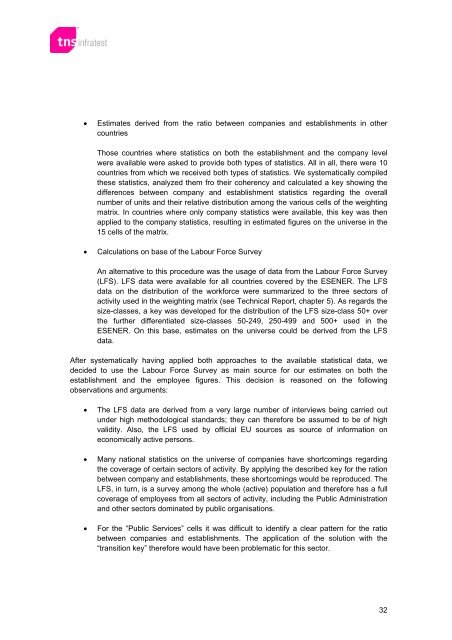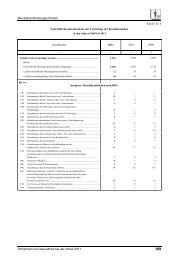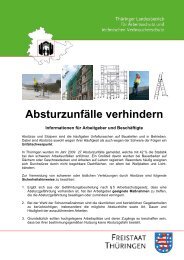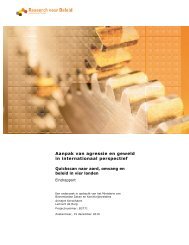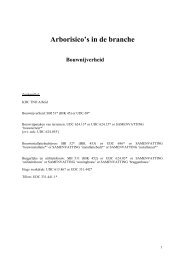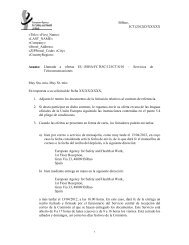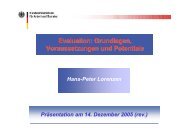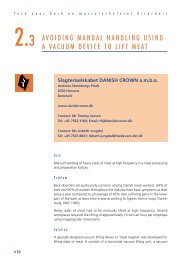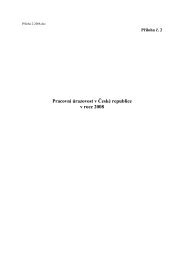ESENER-PSR 2009 - European Agency for Safety and Health at Work
ESENER-PSR 2009 - European Agency for Safety and Health at Work
ESENER-PSR 2009 - European Agency for Safety and Health at Work
Create successful ePaper yourself
Turn your PDF publications into a flip-book with our unique Google optimized e-Paper software.
Estim<strong>at</strong>es derived from the r<strong>at</strong>io between companies <strong>and</strong> establishments in other<br />
countries<br />
Those countries where st<strong>at</strong>istics on both the establishment <strong>and</strong> the company level<br />
were available were asked to provide both types of st<strong>at</strong>istics. All in all, there were 10<br />
countries from which we received both types of st<strong>at</strong>istics. We system<strong>at</strong>ically compiled<br />
these st<strong>at</strong>istics, analyzed them fro their coherency <strong>and</strong> calcul<strong>at</strong>ed a key showing the<br />
differences between company <strong>and</strong> establishment st<strong>at</strong>istics regarding the overall<br />
number of units <strong>and</strong> their rel<strong>at</strong>ive distribution among the various cells of the weighting<br />
m<strong>at</strong>rix. In countries where only company st<strong>at</strong>istics were available, this key was then<br />
applied to the company st<strong>at</strong>istics, resulting in estim<strong>at</strong>ed figures on the universe in the<br />
15 cells of the m<strong>at</strong>rix.<br />
Calcul<strong>at</strong>ions on base of the Labour Force Survey<br />
An altern<strong>at</strong>ive to this procedure was the usage of d<strong>at</strong>a from the Labour Force Survey<br />
(LFS). LFS d<strong>at</strong>a were available <strong>for</strong> all countries covered by the <strong>ESENER</strong>. The LFS<br />
d<strong>at</strong>a on the distribution of the work<strong>for</strong>ce were summarized to the three sectors of<br />
activity used in the weighting m<strong>at</strong>rix (see Technical Report, chapter 5). As regards the<br />
size-classes, a key was developed <strong>for</strong> the distribution of the LFS size-class 50+ over<br />
the further differenti<strong>at</strong>ed size-classes 50-249, 250-499 <strong>and</strong> 500+ used in the<br />
<strong>ESENER</strong>. On this base, estim<strong>at</strong>es on the universe could be derived from the LFS<br />
d<strong>at</strong>a.<br />
After system<strong>at</strong>ically having applied both approaches to the available st<strong>at</strong>istical d<strong>at</strong>a, we<br />
decided to use the Labour Force Survey as main source <strong>for</strong> our estim<strong>at</strong>es on both the<br />
establishment <strong>and</strong> the employee figures. This decision is reasoned on the following<br />
observ<strong>at</strong>ions <strong>and</strong> arguments:<br />
The LFS d<strong>at</strong>a are derived from a very large number of interviews being carried out<br />
under high methodological st<strong>and</strong>ards; they can there<strong>for</strong>e be assumed to be of high<br />
validity. Also, the LFS used by official EU sources as source of in<strong>for</strong>m<strong>at</strong>ion on<br />
economically active persons.<br />
Many n<strong>at</strong>ional st<strong>at</strong>istics on the universe of companies have shortcomings regarding<br />
the coverage of certain sectors of activity. By applying the described key <strong>for</strong> the r<strong>at</strong>ion<br />
between company <strong>and</strong> establishments, these shortcomings would be reproduced. The<br />
LFS, in turn, is a survey among the whole (active) popul<strong>at</strong>ion <strong>and</strong> there<strong>for</strong>e has a full<br />
coverage of employees from all sectors of activity, including the Public Administr<strong>at</strong>ion<br />
<strong>and</strong> other sectors domin<strong>at</strong>ed by public organis<strong>at</strong>ions.<br />
For the “Public Services” cells it was difficult to identify a clear p<strong>at</strong>tern <strong>for</strong> the r<strong>at</strong>io<br />
between companies <strong>and</strong> establishments. The applic<strong>at</strong>ion of the solution with the<br />
“transition key” there<strong>for</strong>e would have been problem<strong>at</strong>ic <strong>for</strong> this sector.<br />
32


